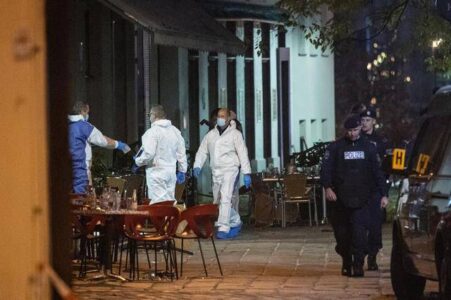
Fear of a fresh Islamic State terror attack strategy grips Europe
A string of ISIS terrorist attacks across Europe, which have left at least seven dead, is thought to be part of a carefully-planned pre-lockdown strategy by the group.
At least four people were killed on Monday and many more seriously injured in a series of shootings across Vienna, which came just days after three people were killed in Nice and a further three plots were thwarted in France.
Terrorism experts have told The National that an ISIS plot to target Europe cannot be ruled out and say the group is taking advantage of the pre-lockdown focus in many parts of the continent.
On Tuesday, Austria’s Interior Minister Karl Nehammer said one of the attackers, who was shot dead by police in Vienna, was “an Islamist sympathiser”.
He has been named as Kujtim Fejzulai, a 20-year-old of Albanian origin, who had grown up in Vienna and was known to security services. He was killed by police while wearing a fake suicide vest.
In Nice, the attacker Brahim Aioussaoi is believed to be an ISIS soldier and had recently arrived in France from Tunisia.
A clergyman and two parishioners were killed after they were partially beheaded by their assailant last Thursday.
It came just weeks after the decapitation of a school teacher in the Paris suburbs by another extremist.
Hans Josef Schindler, director of think tank the Counter Extremism Project, told The National the Vienna attacks were well-planned, adding that the terrorists’ intention was to exploit the pre-lockdown period to target people gathering on their last night of freedom.
“The attack in Vienna seems to have been fairly well co-ordinated,” he said.
“It took advantage of the large amount of civilians being in bars and restaurants during the last evening before a new national lockdown was taking effect.”
Mr Schindler added that the latest incident had all the hallmarks of meticulous preparation, more so than the recent attacks in France.
“The attacker used a firearm and seemed to have had a certain level of competency in using it,” he said. “This requires training, in particular when using such a weapon in a highly stressful situation. Therefore, it seems very likely that the attacker had some – at least – paramilitary training.
“The problem is that after such a string of ‘successful’ terrorist operations in France, it is hard to distinguish whether other attacks are part of a wider plan or whether they are happening because radicalised individuals feel additionally motivated to do something in their area as well.
“However, what is clear is that the Vienna attacker and his potential accomplices have chosen the timing and the location for the attacks very smartly. The preparations, the procurement of weapons and ammunition and possible training, must have been planned for quite a while and last night presented a window of opportunity before the target environment would have become very depleted again due to the national lockdown.”
Security expert Matteo Pugliese, from the University of Barcelona, said ISIS had issued a rallying call to its followers to commit attacks on Europe using its social media platforms.
But he said it was too early to say what had motivated the Vienna attacker.
“He was very young and it’s more likely he radicalised online or with some peers. He probably was fascinated by ISIS digital propaganda. For sure, he didn’t do this completely alone, he had some logistics support for weapons,” he told The National.
“ISIS recently asked its followers to carry out attacks in Europe, but it seems this terrorist decided to take action autonomously and to pledge allegiance to ISIS just before the attack.
“The attacker was among at least 90 individuals stopped by the authorities from travelling to Syria.”
In the last two years Austria has cracked down on radicalisation and shut down several mosques.
It followed the case of Mirsad Omerovic, who ran an ISIS terrorist cell in Vienna and in 2016 was jailed for 20 years.
He is believed to have been responsible for recruiting more than 160 youngsters in Vienna.
Omerovic was allegedly responsible for radicalising Austrian teenagers Samra Kesinovic, then 17, and Sabina Selimovic, then 15, who joined ISIS in April 2014, becoming worldwide poster girls for the group.
Austrian prosecutors claim he “brainwashed” dozens of young people into joining ISIS in Syria.
Mr Pugliese believes the Omerovic cell and Monday’s attacks may be connected.
“Some underground networks could still be operating,” he said. “There could be some link between Omerovic’s network.”
Veronika Hofinger, who works in counter-terrorism in Vienna, told The National that the latest attacks came without warning.
“I don’t know of any actual warnings,” she said. “We were all so focused on the lockdown, starting today.”
In March, academics in Austria published research into the ISIS threat following two government reports into the issue.
It is estimated up to 300 Austrians have joined ISIS, making it one of the European countries with the highest per-capita share of foreign fighters.
“Although the situation in Austria cannot be compared to the challenges in other European countries, such as France, our study identifies existing problems,” said Ms Hofinger in a report.
“Respondents who have served a prison sentence all came into contact with extremist ideas or inmates there, but most of them were not radicalised in jail.”
Monday’s attack was the first ISIS attack on Austrian soil, with previous plots in the country having been thwarted.
Source: The National News





